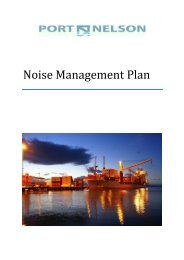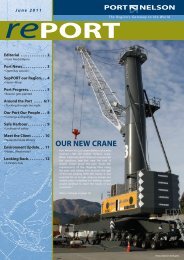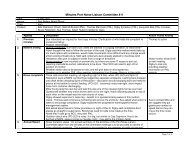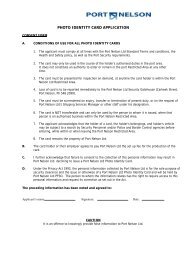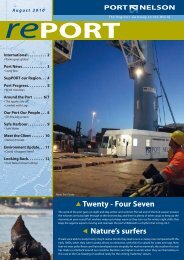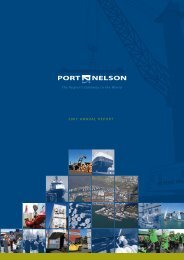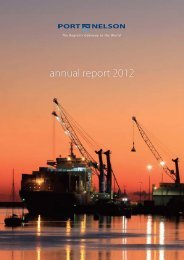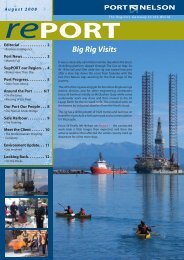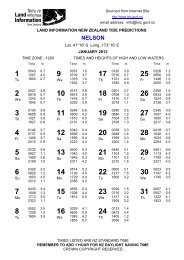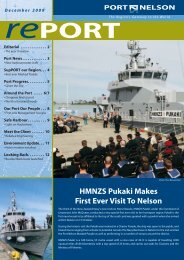April 2009 (pdf) - Port Nelson
April 2009 (pdf) - Port Nelson
April 2009 (pdf) - Port Nelson
You also want an ePaper? Increase the reach of your titles
YUMPU automatically turns print PDFs into web optimized ePapers that Google loves.
<strong>Port</strong> <strong>Nelson</strong> Limited report. <strong>April</strong> <strong>2009</strong>. Page 12<br />
looking back<br />
That’s how Thomas Cawthron<br />
(1833 -1915) was described<br />
by his biographer, David<br />
Miller. The name lives on<br />
with the Cawthron Institute,<br />
and most <strong>Nelson</strong>ians could<br />
probably tell you that<br />
Cawthron donated the<br />
Church Steps and the chains<br />
along Rocks Road. But it<br />
wasn’t until the end of last<br />
year that the <strong>Nelson</strong> Tasman<br />
Chamber of Commerce, as<br />
part of its 150th anniversary<br />
celebrations, made Thomas<br />
Cawthron an inaugural<br />
inductee of its Hall of Fame.<br />
It’s also not widely known<br />
that Cawthron’s business<br />
dealings were largely based<br />
around the port, and his first<br />
office was in a wrecked ship.<br />
Thomas Cawthron<br />
Businessman and Benefactor<br />
“<strong>Nelson</strong>'s most philanthropic citizen whose bountiful generosity has<br />
done so much for the welfare of its people.”<br />
Cawthron arrived in New<br />
Zealand with his parents in<br />
1849, but was soon lured<br />
over the Tasman to the goldfields. Returning a few years<br />
later he started out in business with a contract to dig the<br />
test drives for copper deposits on the Dun Mountain; going<br />
on to provide supplies for the copper-mine, and setting up<br />
office in the beached hulk of the Albion at <strong>Port</strong> <strong>Nelson</strong>. The<br />
business developed as a general merchant and Cawthron<br />
made the most of new opportunities: when steam ships<br />
brought an increased demand for coal, he got involved with<br />
the development of the Enner Glynn Coal Mine, and when<br />
gold was discovered in Golden Bay, he shipped miners' stores<br />
and equipment to the boom towns. Gold had a huge impact<br />
on <strong>Port</strong> <strong>Nelson</strong>, trebling inward cargo between 1860 and<br />
1865, and making the port attractive to regular calls from<br />
steam ships for the first time.<br />
Photo supplied by Cawthron Institute.<br />
Cawthron amassed shipping<br />
agencies, starting with the<br />
Panama Royal Mail Steamship<br />
Co in 1859, and by 1876,<br />
when the Union Steam Ship<br />
Company of New Zealand<br />
took over the New Zealand<br />
Steam Shipping Company, he<br />
had a monopoly of shipping<br />
agencies in <strong>Nelson</strong>, controlling<br />
practically the whole of the<br />
maritime shipping from the<br />
busy port.<br />
Cawthron’s ‘Midas Touch’<br />
carried over to his investments<br />
in shares and property and<br />
by the time he retired in<br />
the late eighties he had a<br />
considerable fortune. He had<br />
a reputation as a miser, but<br />
quietly gave money to many<br />
causes, and was influenced<br />
by his friends to make his<br />
bigger civic donations.<br />
These include the Church<br />
Steps, the chains and posts along Rocks Road, extensions to<br />
<strong>Nelson</strong> Hospital and nurses' home, a 1000ha reserve near Dun<br />
Mountain and the organ at the <strong>Nelson</strong> School of Music. Seven<br />
years after his death the Cawthron Institute was founded, and<br />
has done major research on soils, agriculture and biochemistry,<br />
while playing an important role in stimulating government<br />
scientific research.<br />
Today one of the Cawthron Institute’s strengths is marine<br />
research. Cawthron scientists carry out the surveys and<br />
reports that are used in support of <strong>Port</strong> <strong>Nelson</strong>’s consents<br />
for dredging work, and they make a valuable contribution to<br />
our Environment Committee on issues from water quality to<br />
marine invaders.<br />
Sources: Karen Stade, The Prow (local history website); Margareta Gee, Dictionary of NZ Biography 2007; and Theodore Rigg, Encyclopaedia of NZ, 1966.<br />
Image below Edwin Harris from The History of <strong>Port</strong> <strong>Nelson</strong>, Ruth Allan 1954.<br />
The Albion Wharf in the late 1870s.



